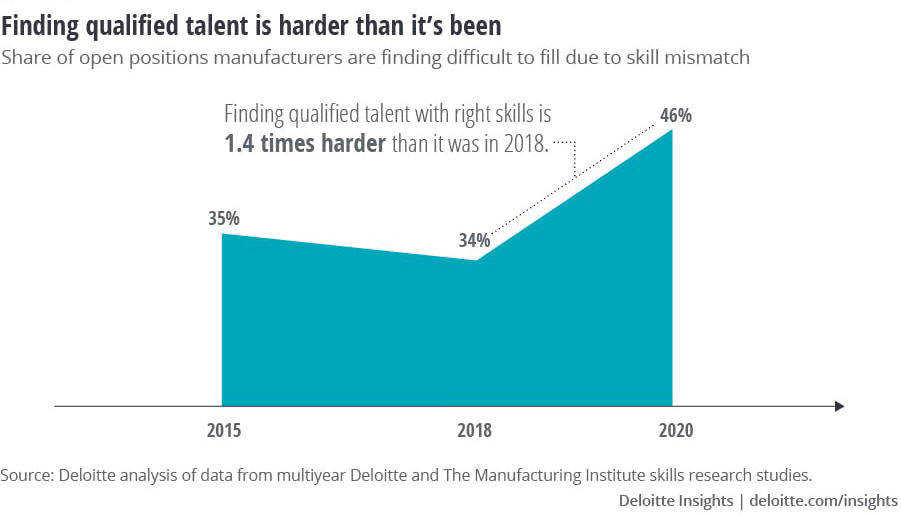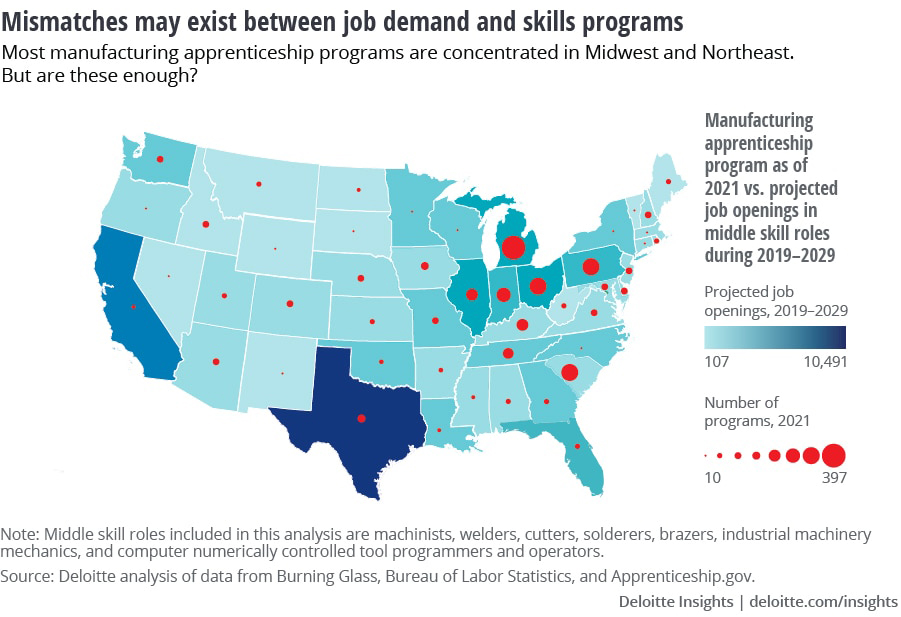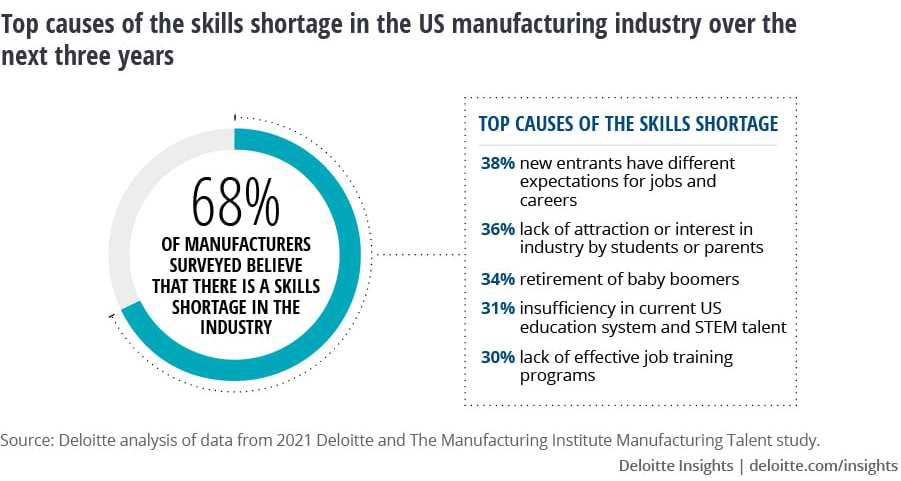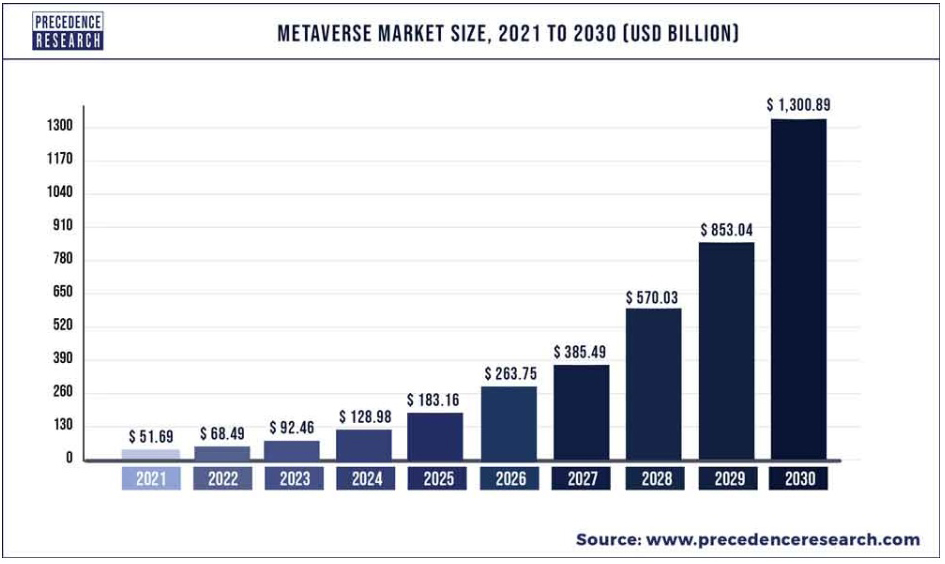What meaningful opportunities will metaverse technologies offer manufacturing?
As a New Year dawns, the resounding cry from manufacturers is: Where are the people? Far and away, the top challenge facing manufacturers in 2023 will be the ongoing skilled labor shortage. Experts say there simply are not enough people to fill manufacturing roles, especially amidst reshoring efforts. The labor shortage is one of many moving pieces shaping the manufacturing workforce—and the workforce as a whole—and these shifts, combined with the convergence of technology trends in Industry 4.0 and the IoT (Internet of Things) and national manufacturing trends like reshoring efforts, are all coming to a head.
Meanwhile, the metaverse is trending not only in the social media-verse but also in enterprise circles. What meaningful opportunities will metaverse technologies offer in the manufacturing space? How will what’s happening in metaverse intersect with what’s happening in the manufacturing workforce?
2023 Manufacturing Trends to Watch
In the next year, Mark Schuerman, senior manager of business development for Molex, says trends impacting the manufacturing space will include the workforce’s desire for flexibility, rising costs of labor due to shortages and impact of inflation, the availability of and need to invest in smart manufacturing technologies, an awareness within manufacturing companies of their vulnerability to disruptions (in large part because of the pandemic), and a general shortage of workers, both skilled and unskilled. “All the above factors are driving the desire and requirement for increasing levels of automation at manufacturing companies to mitigate risk exposure to labor and supply chain disruptions while driving operational efficiencies higher,” Schuerman says. “The trend is toward using automation to produce more with a smaller workforce.”
And while automation and Industry 4.0 are important trends in manufacturing, Jeannine Kunz, chief workforce development officer at SME, stresses manufacturers still need people to enable their digital transformations. “There simply aren’t enough people to fill roles,” Kunz says. “Automation and Industry 4.0 (are becoming) important aspects of rethinking how we do things. However, we still need people for automation and digitization. And those people need to be part of the change.”

Kunz says right now, there is a significant shift in what people expect from their employers. “I personally think we are overlooking what is happening with the ‘worker’ themselves,” she explains. “Individual priorities, beliefs, and lifestyles are changing. Their expectations and social contract with their employer are changing. […] The nature of work was already shifting with the new generations entering the workforce, and with the changes related to Covid, the workforce challenges have grown. This creates a myriad of challenges to address in finding, developing, and retaining a skilled and engaged workforce to drive our industry forward.”
The pandemic, the changing employee-employer relationship, the economy—it’s all part of what’s happening in workforce as a whole, but the manufacturing space in particular is suffering. A 2021 study by Deloitte and The Manufacturing Institute anticipated that 2.1 million manufacturing jobs could go unfilled by 2030 due to skilled labor shortages and a wave of baby-boomer retirements.
Tony Schmitz, professor at the University of Tennessee, Knoxville and joint faculty at Oak Ridge National Laboratory, says this reality is partly because manufacturing has not been promoted as a viable career to high school students in recent decades. “This has produced a shortage of students entering four-year and two-year manufacturing education programs,” Schmitz explains. “Second, manufacturing has changed significantly in recent decades. It is now mostly a digital enterprise that requires new skill sets than the training received by the baby boomers that make up much of the manufacturing workforce. We need to recruit, but we need to make sure we’re recruiting using an accurate representation of the field and its opportunities.”

Manufacturing is a high-tech, high-reward career that leverages the latest technologies, and it matters a lot. U.S. manufacturing influences the nation’s economy and its global viability as a competitive force. Schmitz points to competitions like the SEC Machining Competition held in November as examples of how universities are working to raise up the new generation of manufacturing workforce.
Liz Stuck, senior director of workforce development at MxD, says one consequence of the critical skills shortage that shouldn’t be overlooked is the corresponding security risk to the manufacturing sector. “The growing skills gap becomes even more concerning when considering that manufacturing is the most targeted sector for cyber-attacks,” she says. “Thirty-five percent of cyber-espionage attacks in the U.S. are targeted at manufacturing, the largest of any single sector.”
Reshoring is compounding the workforce problem. Conrad Leiva, vice president of ecosystem and workforce education at CESMII – The Smart Manufacturing Institute, says: “In general, we’ve had an increase of manufacturing coming back to the country through reshoring. And a lot of that has been driven by the realization that we’ve had overexposure to risk in our supply chain during the pandemic disruption. […] Manufacturing fell out of fashion because we were sending it offshore for so many years, and now that we’re trying to make things again, the labor’s not there. It takes a few years to build up the interest and the talent pipeline.”

With boomers retiring and not enough workers coming in, the skills gap between the new generation and the old, and all of this amidst reshoring, it’s no wonder experts cite workforce issues over and over as the top manufacturing trend to watch in 2023. However, no trend happens in a vacuum. Trends evolve simultaneously and often intersect to form new trends. One example is how workforce trends in manufacturing and the buzz about the metaverse are creating a fascinating dialogue about what could be.
Making Way for the Industrial Metaverse
Precedence Research estimates the global metaverse market will exceed $1.3 trillion by 2030, which is up from $51.69 billion in 2021. MxD’s Stuck defines the industrial metaverse as the ability to combine virtual technologies like VR (virtual reality), AR (augmented reality), and digital twins with real life to improve processes and increase efficiencies. She says: “The industrial metaverse allows collaboration between a digital environment and a real-world environment in a way that can potentially prevent problems from happening to begin with by analyzing the data and outputs from the digital environment and applying them to the real-world environment.”
John Liu, principal investigator at MIT’s LEAP (Learning Engineering and Practice) Group, a lecturer in MIT’s Dept. of Mechanical Engineering, and a scientist at the MITx Digital Learning Lab, describes the industrial metaverse as an evolution of the digital representation of whole systems composed of environments, products, processes.

“Think ‘digital twin’, but now, instead of the typical single machine or process, it could be a whole factory, transportation system, or energy grid,” Liu explains. “Of course, simulating and optimizing production lines has also been used in the industry for some time now. The industrial metaverse is a step forward in that it includes increased complexity and power. It will integrate into one package aspects such as physics-based behavior, material types, human ergonomics, and photo-realistic models.”
Liu imagines the industrial metaverse impacting the workforce in three areas: type of work, education and training, and pipeline. First, he says, the type of work will change. “I imagine we would see the emergence of new occupations like digital thread or digital twin engineers or a greater focus on human ergonomics and productivity to fully virtual and hybrid interactions,” he says. “We will probably see in the next 10 years the establishment of best practices on how to interpret and sift through richer and more complex data and how to drive these insights towards decisions.”
Second, the industrial metaverse will impact education and training in manufacturing. Liu says as industries spawn new technologies at a dizzying pace, companies cannot thrive without a nimble workforce, and one way to make a workforce nimbler is to leverage innovative solutions that improve education, training, and productivity. “The workforce needs to more quickly adapt to new technology, digitally upskill, and learn to work better with automation,” says Liu. “And how to do all of this at scale? Having a seamless integration between the virtual and physical worlds is perfect for the workforce to learn these competencies. […] The metaverse could enable education and training for the workforce with an authenticity, connectedness, and scale we haven’t seen before.”
Finally, there’s the industrial metaverse’s potential impact on the manufacturing workforce pipeline. Liu says manufacturing is struggling to recruit new workers at a rate that matches retirement rates and local surges in demand, and part of the issue is that manufacturing has “an image problem”. While manufacturing is advancing, the public still thinks manufacturing is dirty, dangerous, and dark.
4 Ways the Metaverse Will Intersect with Manufacturing
Mark Schuerman of Molex lists four ways manufacturing and metaverse will intersect.
- During the design process, the industrial metaverse will serve as a tool to optimize ergonomics and overall worker health and safety. It will also allow manufacturing engineers to virtually test different production strategies in terms of choices of equipment and use of manual vs. automated systems to achieve more efficient production strategies upon implementation.
- AR/VR tools will be used for worker training to help them practice and improve production, as well as maintenance techniques.
- AR/VR tools will also be used to assist workers during the production and maintenance processes themselves. For example, AR goggles can direct workers through each stage of a manufacturing process, helping to inform them of which steps need to be performed and when, as well as performing a quality-control function by monitoring and confirming all parts are installed in the correct order and to the proper manufacturing specifications. If a step is missed or a part is not installed properly, the line can be stopped and corrective actions can be communicated to workers in realtime.
- The industrial metaverse also provides opportunities for suppliers to provide remote, virtual assistance to line workers when diagnosing and troubleshooting equipment in need of repair. A specialist from a supplier can remotely “go online” and work with a maintenance person virtually in the metaverse to observe the problem and devise a corrective strategy with the end-user maintenance team without having to travel to the facility.
“I see the metaverse potentially impacting the workforce pipeline in two ways,” Liu adds. “One, if you can experience manufacturing in the virtual world with the same realism as that of the physical, job seekers and young people can—not just become aware—but experience for themselves the greatest manufacturing work has to offer. A child could roleplay as a robotics engineer, or a high school student could already begin learning what it takes to succeed in manufacturing operations. Second—and this is more of a moonshot—you might be able to open up remote work for physical work. Today, remote work is commonly available for work like software development or project coordination. But when it comes to physical work, of course you have to be there. Many people won’t move for a job, especially if they’re entry-level. That’s why the accessible workforce for a plant is largely constrained to a region. But if you combine virtual 100% operational transparency, low latency networks, and advanced robotics, could someone in Atlanta work in a Detroit factory as if she were there? The option to offer remote physical work could take a locally concentrated spike of job demand and re-distribute it across the nation to better match supply. And if physical work can be done virtually, we could open up physical work to new populations like the physically disabled.”
Salim Awad, president and CEO of SPINNER North America, says an engaged and skilled workforce are fundamental elements to the future of manufacturing, and metaverse will play a role in creating an engaged, skilled workforce, as well as creating other valuable opportunities. “The metaverse, although still in its infancy, presents meaningful opportunities for advanced manufacturing, where it can be utilized for training, simulations, and process development,” Awad says.
Collaboration in manufacturing will also benefit from metaverse technologies. For instance, Awad describes how older and soon-to-be-retired workers possess immense knowledge that must be transferred to the incoming workforce. “A great way to make this transfer of knowledge and experience is to build multigenerational teams where an exchange of ideas, as well as mentoring and coaching, can take place in a healthy ecosystem,” he adds. “Manufacturing leaders must create the conditions for this exchange and intentionally build the teams that allow a successful and collaborative transition.”
MIT’s Liu agrees the industrial metaverse has far-reaching implications for collaboration in manufacturing and beyond. “Colleagues from around the world will now be able to work in the same virtual world, troubleshooting the same real-world problem or trying out different ideas together,” he explains. “And information that is not normally available to the naked eye is now readily visualized, so groups can more easily extract the most useful insights from complex data and make better decisions.”
But while the metaverse demonstrates exciting potential and some early successes, Liu points out the collection of technologies that compose it are still nascent, and no one knows what it will really turn out to be. “As a whole, we humans have a spotty record towards making accurate predictions,” Liu says. “It’s easier to discuss potential and harder to accurately predict what the metaverse will turn out to be and the greatest ways it will actually impact the industry.”
CESMII’s Leiva says there’s no need to wait for a metaverse to realize a lot of value with digital transformation and smart manufacturing technologies. “It’s easy to get fascinated with the potential of future technologies, but we don’t want to forget that right now there are a lot of opportunities to implement smart manufacturing technologies that are available today,” he says. “It more practical than ever for small- to medium-sized manufacturers to modernize their practices and become more digital-ready for today’s connected digital supply chain. I get excited too about (the) future, but there is a lot of stuff to do right now and a lot of technology available that is helping manufacturers today.”
Links for Further Learning:
- Deloitte’s “Creating pathways for tomorrow’s workforce today: Beyond reskilling in manufacturing”
- NAM’s 2022 3rd Quarter Manufacturers’ Outlook Survey
- Precedence Research metaverse market research
- Gartner’s “What Is a Metaverse? And Should You Be Buying In?”
Want to tweet about this article? Use hashtags #IoT #sustainability #AI #5G #cloud #edge #digitaltransformation #machinelearning #futureofwork #cybersecurity #metaverse #manufacturing #supplychain #trends #AR #VR #automation #digitaltwin #industry40 #skillsgap #industrialmetaverse #Molex #SME #MxD #CESMII #SPINNNER


